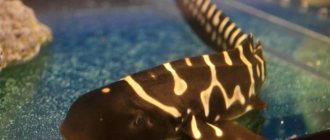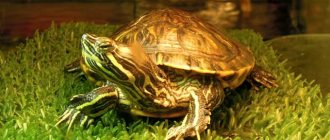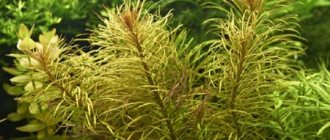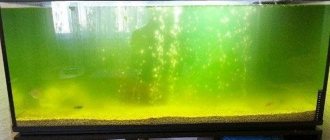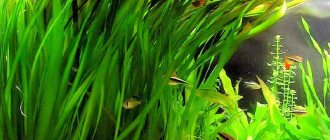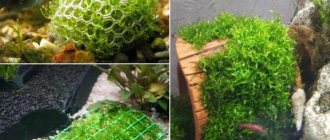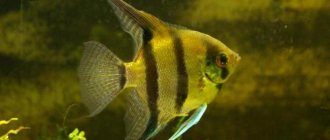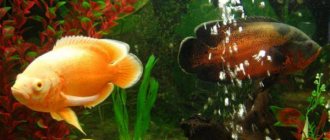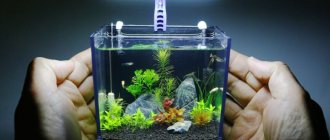Part 3. Most popular: Ludwigia
In Soviet times, there were only four pet stores in Moscow that sold aquarium products - on Arbat, on Kuznetsky Most, on Leninsky Prospekt and on Shchelkovskoye Highway near the Lilac Garden. Aquarium plants were extremely rare in them: they were usually not accepted for commission from the population, and Moszookombinat centrally grew only three species - pistia, Carolina cabomba and Ludwigia repens. I don’t know for what reason, but they were unable to produce commercially with other plants... Therefore, LUDWIGIA was present in the household of almost every Soviet aquarist with varying degrees of success.
Currently, a dozen species of Ludwigia grow in domestic aquariums. In addition to the veteran of the domestic aquarium hobby - Ludwigia repens and L. palustris and L. peruensis, which are very close to it, the holly-leaved L. arcuata, the brightly fiery L. glandulosa, similar to the alternanthera, and many others have mastered the aquariums of hobbyists.
Reproduction and planting
The process is quite simple. It is enough to separate the cuttings from the stems, about 10 cm in size. Then you can leave them floating until they develop roots, or immediately plant them in the ground.
In addition to the aquarium, Ludwigia gets along well in a paludarium and greenhouse with a high level of moisture. In order to make it a land plant, first it is planted in soil covered with water. When it produces new stems, they are transplanted into a mixture of sand, humus, or peat and garden soil. After some time, the plant will take root and resume growth. It is important to provide him with strong diffused lighting at this time.
Ludwigia repens
Let's start with the classics. Ludwigia repens (synonym: Ludwigia natans) is a traditional inhabitant of our aquariums. In nature, this species is common in standing and slow-flowing reservoirs of North and Central America. It grows in a semi-flooded state, while the underwater leaves have a bright red color, and the surface leaves, which differ significantly in shape, are dark green and leathery.
In order for Ludwigia repens to have an attractive appearance in the aquarium and please the eye with the red color of the leaves, it needs a temperature no higher than 26 degrees (lower is better), fine, nutritious (but not sour!) soil, additional fertilizing with ferrous iron preparations and relatively bright light with short periods of time. daylight (0.4 Watt/liter for 9-10 hours a day). In the literature, 12 or more hours of daylight are often recommended for it, but in practice, following this advice is dangerous: it is easy to “grab” fouling with green algae, which can be fatal for the plant. Experienced aquarists often install additional lighting with old incandescent light bulbs - Ludwigia reacts to their spectrum by enlarging and reddening the leaf blades. The supply of CO2 accelerates the growth of ludwigia, which is not always useful. The stems that have reached the surface must be cut off in time at a height of approximately 1/2 the height of the plant and planted again in the ground next to the mother shoot. Like most other types of ludwigia, the creeping one branches strongly and actively, so that even from 2-3 shoots a beautiful dense bush will soon form.
Water hardness and pH are not significant for L. repens, but it really does not like soil acidification and nitrogen accumulation in water. In unfavorable conditions, the lower half of the plant’s stem sheds its leaves, darkens, and soon the stem rots at the very root, sending the apparently healthy plant into “free floating.” In nature, this is an adaptive mechanism that allows Ludwigia to “escape” from that part of the reservoir where life has become uncomfortable. In an aquarium, if this happens, you should take care of the condition of the soil, filter and more frequent water changes (optimally - 25% once a week or more often), as well as lighting. Sometimes Ludwigia “runs away” simply because it is drowned out and shaded by neighboring plants. In large pebbles, roots do not develop, and the plant begins to hurt. This Ludwig does not like great depth either. In aquariums with a water column of more than 40-45 cm, it begins to stretch out, wither, and shows obvious signs of ill health. The presence of turbidity and suspension in the aquarium causes a defensive reaction in her: the leaves on which the suspension has settled will most likely be discarded. The plant reacts equally painfully to algae fouling, which should never be allowed to occur.
Ludwigia natans "super red"
If you plant Ludwigia in a low (15-20 cm) open aquarium with good overhead light, it easily “jumps out” of the water, gives off aerial shoots and blooms. However, it will not be possible to propagate it with seeds in an aquarium, and there is no need to - it reproduces well by dividing the stems. Pieces of stems 10-12 cm long with 5-6 pairs of leaves root well and quickly produce many side shoots.
In recent years, several varieties of this species with bright red foliage have been developed (Lr “Red”, lr “Superred”, Lr “Rubin”, etc.). The conditions for their maintenance do not differ from those for the original species, except that they require a couple of degrees higher temperature and two to three times brighter lighting (not 0.4, but 0.7 - 1.2 watts per liter). With a lack of light, the “ruby” forms of L. repens rapidly become bald from the lower part of the stem, giving the classic “palm tree” effect.
Ludwigia disease: symptoms, causes, treatment
Almost all diseases of all types of ludwigia are associated with violation of the rules for the care and maintenance of this plant in the aquarium. Exceeding the acidity and hardness of water, insufficient filtration, aeration and regular water renewal very often leads to the death of the plant.
The lack of optimal additional lighting also causes Ludwigia to feel discomfort and show various signs of disease - yellowing and paleness of the leaves, the appearance of holes on them, the plant being covered with green, red or brown algae, and much more.
Sometimes the causes of Ludwigia diseases can be the poor condition of the soil, which needs to be replaced or thermal disinfection carried out in order to destroy the pathogenic flora.
Very often, ludwigia diseases are caused by a lack of mineral components in water, containing nitrogen, potassium, calcium, magnesium, iron or phosphates. To prevent this, it is necessary to carry out timely and competent feeding of Ludwigia with special complex aquarium fertilizers.
By following all the above rules for maintaining and caring for Ludwigia, you will be able to enjoy the extraordinary beauty of this ancient exotic plant for a long time.
Ludwigia swamp
The next most popular and widespread species of Ludwigia is Ludwigia palustris. Originating from the American continent, this species can today be found in fresh water bodies of almost the entire subtropical zone of the planet. Unlike many other introduced species (“invaders”), swamp ludwigia does not cause environmental problems and does not give rise to violent outbreaks. On the contrary, it successfully fits into the local biotopes almost everywhere, without disturbing the existing balance. Coming out of the aquatic environment into the air, this type of ludwigia does not form a floating rosette, but continues to grow upward, only its leaves become more leathery, narrow, with a pronounced central vein.
In the aquarium, the leaves of Ludwigia repens are smaller than those of Ludwigia repens, and the red color appears only on the underside of the leaf in good conditions. The plant actively branches, creating lush bushes in the aquarium, more compact than those of the previous species. But more light is required. If you give it 0.4 Watts per liter (quite sufficient for Ludwigia repens), L. marsh will begin to “stretch”, increasing the internodes, losing redness and decorativeness. But it is not sensitive to temperature, developing well at both 16° and 30°C.
Otherwise, the conditions of detention and the method of reproduction do not differ from the previous species. Intolerance to turbidity and suspension is characteristic of this species in the same way as the previous one.
Ludwigia swamp in the supermarket
Ludwigia swamp in a pot
a
Ludwigia swamp
Ludwigia swamp green
In addition to the natural form, the culture also contains the Lp “Green” variety, distinguished by bright green leaves without any red admixture. This form is even more sensitive to water transparency and the absence of algal fouling.
“Opposite” forms of this species also appeared - with bright red leaves. Ludwigia palustris “Super Red” and “Super Red Mini” are found in Asian and European catalogs of wholesale companies, but these varieties have not yet reached the domestic market, and therefore it is too early to write anything about their characteristics.
The Peruvian ludwigia (Ludwigia peruensis) differs from the marsh ludwigia, in fact, only in its homeland: if the marsh ludwigia inhabits small standing reservoirs of Central America, then the Peruvian ludwigia inhabits the same swamps of the Pacific coast of South America. The conditions of their detention are identical.
Peruvian Ludwigia
Peruvian Ludwigia
Ludwigia arcuate and Ludwigia brevis
It is no coincidence that we describe these species together. The fact is that even experienced aquarists, as a rule, do not know which of these almost indistinguishable species of “needle-shaped” ludwigs grows in their aquariums. The confusion is aggravated by the fact that in the catalogs of foreign wholesale companies, often no one even thinks to distinguish between these American plants, selling them under the general name “Ludwigia arcuata”. By the way, one can add to the same confusion the commercially available “species” Ludwigia oblongofolia and L.pedunculosa, which are most likely geographical forms of arcuata. However, this does not bother us at all, because... and in nature they grow in similar biotopes, and in aquariums Ludwigia brevipes and L.arcuata require the same conditions. The specific name of one of these plants “short” is no coincidence: in an aquarium, the length of the stems of narrow-leaved ludwigia rarely exceeds 25-30 cm, and when planted to a depth of more than 50 cm, the plant will most likely gradually wither and die.
“Needle-shaped” ones differ from other types of ludwigia by their narrow, long leaves. With good lighting (more than 0.8 Watt/liter), their leaves become even more elongated, narrowed and acquire a noble shade of mahogany. However, both in partial shade and in low light (0.2-0.3 Watt/liter), needle-shaped ludwigs (unlike classic ones) do not wither and do not shed their lower leaves, but continue to grow and develop, losing only their reddish-brown color . For this group of species (or subspecies?) of Ludwigia, the nutritional value of the soil is not very important: their roots are much less developed than those of their sisters L. creeping and L. swamp, and these plants receive their main mineral nutrition from water. They can be kept floating for a long time (months) in an aquarium without soil, practically without causing them any harm.
Ludwigia arcuate
Ludwigia longifolia
Ludwigia arcuate
Otherwise, the conditions of their detention are the same as those of Ludwigia Repens. They are also afraid of turbidity and suspended matter in the water, and are not resistant to algae fouling, but they can easily tolerate fluctuations in water hardness and temperature over a fairly wide range: hardness from 1 to 20 degrees, temperature 18–30 ° C. Plants gratefully respond to fertilizing with liquid iron-containing fertilizers, but supplying CO2 makes sense only if the illumination exceeds 0.7 Watt/liter. It is sometimes written in the literature that when illuminated with old incandescent lamps, needle-shaped species of Ludwigia can acquire a purple color, but the author has never seen specimens of this color.
Description and habitat
Ludwigia is a member of the Onagricaceae, or Fireweed, family. The plant is represented by annual or perennial herbs, less often shrubs. It received its name in honor of the German botanist and physician Christian Gottlieb Ludwig, who was one of the early opponents of Carl Linnaeus.
Ludwigia can be found in tropical and subtropical areas. It is rich in Central and North America. The grass is also found in humid areas of Asia and Africa. The plant inhabits ponds, rivers and lakes. Under natural conditions, Ludwigia can interbreed with other types of herbs.
A representative of the flora is able to exist not only in water. Many of its varieties grow in dry areas.
The ornamental plant has an elegant appearance . Straight stems reach a height of 30−50 cm. Branched shoots are a little harsh. They are covered with simple leaflets arranged oppositely or alternately. The leaf blades are narrow, light green in color. Under favorable external conditions, they acquire a red-brown color. The shape and size of the leaves may vary among different species of Ludwigia. Yellow or greenish flowers with four petals form above the water surface.
The most common varieties of Ludwigia found in aquariums are creeping, arched, and swamp.
Residents of some countries grow grass as a fodder plant. Ludwigia is used in folk medicine and the food industry. There are varieties that are used in textile production: a yellow dye is made from the plant for dyeing fabrics.
In aquarium keeping, Ludwigia is a decorative element. Although this grass has a wide variety of species, it cannot be called widespread. In different countries, aquarists can purchase only a few varieties of this plant.
Ludwigia thrives in greenhouses and paludariums with high humidity levels. Specimens taken from the aquarium are planted in soil watered with water. In such conditions, the grass forms aerial shoots, which are transplanted into a substrate with garden soil, humus and sand. Terrestrial specimens easily tolerate flooding. They quickly adapt to new conditions and resume their growth.
Some grow Ludwigia not only for their aquarium, but also for sale. For bushes, select shallow containers with water, which should contain only the roots of the plants.
Ludwigia oblique and Ludwigia "Cuba"
If we described the previous two types in one chapter because it is impossible to distinguish them, then these are completely the opposite. These two apparently very different plants are actually forms of the same multivariate species, Ludwigia inclinata. The classic “book” form of L. oblique is quite rare in our aquariums, because it shows all its decorativeness only in very good light, CO2 supply and a temperature of at least 25 degrees. This plant is similar to L.repens, but differs from it in its elongated oval, blunt-pointed reddish-olive leaves with sharply defined venation. In non-ideal conditions, it immediately stretches out, loses its red color, lengthens the internodes and “goes bald” with the lower half of the stem, losing all decorativeness. L. oblique does not tolerate transportation and shipping well, for which plant dealers dislike it. But aquascapers don’t like it for its capriciousness and rapid growth. Unlike the previously described species, which are indifferent to the hydrochemical parameters of water, this ludwigia and all its forms prefer softer and more acidic water.
The “Cuban” variety (Ludwigia inclinata (var. verticillata) “Cuba”) in appearance most closely resembles Eusteralis (Eusteralis (Pogostemon) stellata), which will be discussed in the very last part of our “long-stemmed” article. This is a wide, lush plant with narrow, long red-green leaves, sitting along the stem in a dense plume with short internodes. “Cuba” is a large plant suitable for decorating large aquariums; it can withstand significant planting depths (in good light) and forms voluminous bushes. For LiCuba, CO2 supply is highly desirable. It feels great in modern industrial aquascapes of the “Aman” type, with dense continuous planting of plants, water temperature of 26-28 degrees, strong light, powerful filtration and a constant supply of carbon dioxide. It needs silted (but not soured) nutrient soil and liquid mineral fertilizer. In less comfortable conditions, “Cuba” sometimes begins to degenerate, lose its red color and produce wider, blunt-pointed leaves, similar to the leaves of the nominative form of the species.
Ludwigia inclinata “Tornado” differs from “Cuba” only in that its needle-like leaves are curled in a spiral along the central vein. The conditions of detention for these forms are identical.
Placement in an aquarium
Ludwigia red is ideal for creating contrasting compositions. The plant responds well to trimming; this feature allows it to be used in any part of the aquarium. If you plant it in the background, you will get a red and green background, reminiscent of a forest. With regular trimming, due to the growth of shoots, you can get free-standing beautiful plants, suitable for the central part and foreground of an aquarium panorama
Creeping Ludwigia does not tolerate shade; when placing it, it is necessary to avoid proximity to representatives of broad-leaved flora. If the plant does not have enough light, it will stop growing and then die completely.
In an aquarium, the plant performs not only a decorative function. Fry and weakened fish use it for shelter. It purifies water by feeding on organic matter in the water. Enriches the environment with oxygen. Fish hide in it to spawn. In addition, it is food for some aquarium inhabitants. But fish that like to dig will be bad neighbors for this plant. They can simply pull out the ludwigia by the roots.
Ludwigia ferruginosa
This is a rather rare guest in Russia, little known to domestic aquarists. But in vain! In fact, this inhabitant of North American swamps, reminiscent of alternanthera in color and leaf shape, is very beautiful, and at the same time (unlike other ludwigias) is suitable for decorating deep containers, because. capable of producing lashes up to 1 meter or more in height on rich nutrient soils. True, it does not grow quickly on ordinary aquarium soils. Ludwigia glandulosa feels best in “on the ground” aquariums, which have become fashionable in this century (*a special method of organizing plant aquariums, in which a layer of fertile garden soil is laid under a thick layer of fine aquarium soil). She needs very bright light (from 1 Watt/liter). And the temperature is not lower than 25°C. In low light or in cool water, it easily loses its leaves and rots. If everything is in order with both light and root nutrition, then the leaves of this ludwigia become bright scarlet.
Buy Ludwigia ferruginosa in the online store
Buy Ludwigia ferruginosa in the supermarket
Ludwigia oval
This smallest of the aquarium Ludwigias is not of American, but of East Asian origin. The height of its stems does not exceed 15 cm, so it can hardly be called long-stemmed. This is more of a mid-ground plant, which is logical to be placed against the backdrop of dense walls of tall plants, as well as near stones and snags. The nominative form of Ludwigia ovalis has a pinkish-green or yellowish-green color on the upper side of the leaf and reddish on the underside. The “Pink” variety with red-pink leaves is also on sale. Interestingly, unlike most other red-leaved plants, L.ovalis does not lose its redness even in poor light. This species is as unpretentious as L.repens: it is quite content with illumination of 0.5 Watt/liter and is able to grow in a wide range of water hardness and temperature.
- Buy Ludwigia oval
In addition to those described, the species Ludwigia marilia, Ludwigia pilosa, and others are occasionally found in aquariums.
And as a pond plant in heated greenhouse ponds, Ludwigia sedoides - a rather unusual plant, which has a long vertical stem - only a way of “delivering” to the surface a tight, dense rosette of leathery leaves, similar to the leaves of the domestic water chestnut (Trapa natans). On the underwater stem it does not form leaves at all, and is a polygonal rosette of dense jagged leaves lying on the surface, connected to the root system located in the ground by a long flexible cord-like stem.
In the next part we will talk about other equally popular types of long-stemmed plants - ROTALs.
© Aqua Logo Andrey Klochkov
Fields marked with * are required.
Appearance
Ludwigia red has a long, creeping red stem. Moreover, its saturation depends on the level of illumination. The height of the plant is up to 50 cm. The stem has oval leaves. More often there are specimens in which the upper part of the plant is red and the lower part is dark green. Ludwigia red - an amphibian, reaching the edge of the water, it grows higher. If the right conditions are selected for the plant, it blooms, and a bright flower appears on the surface, reaching 0.5 cm in diameter.
